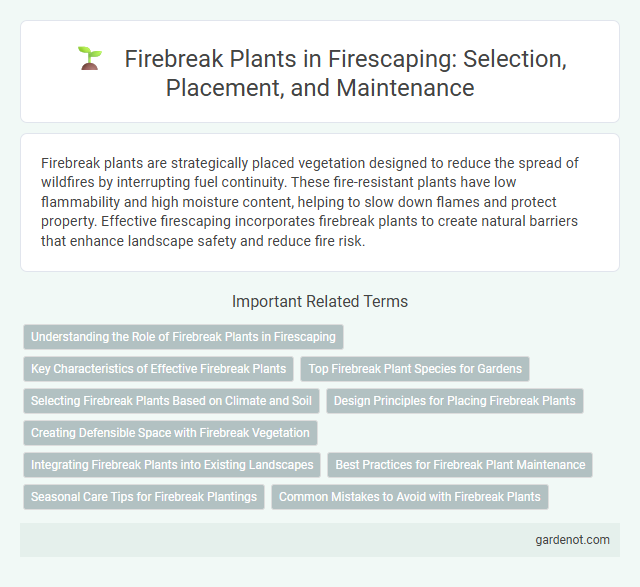Firebreak plants are strategically placed vegetation designed to reduce the spread of wildfires by interrupting fuel continuity. These fire-resistant plants have low flammability and high moisture content, helping to slow down flames and protect property. Effective firescaping incorporates firebreak plants to create natural barriers that enhance landscape safety and reduce fire risk.
Understanding the Role of Firebreak Plants in Firescaping
Firebreak plants play a crucial role in firescaping by acting as natural barriers that slow or halt the spread of wildfires. These plants typically possess low flammability, high moisture content, and dense foliage, creating a break in fuel continuity. Incorporating firebreak plants strategically around properties enhances fire resistance and protects landscapes from devastating fire damage.
Key Characteristics of Effective Firebreak Plants
Effective firebreak plants possess high moisture content, low resin or oil levels, and minimal dead material to reduce flammability. These plants typically have shallow root systems to prevent deep fuel accumulation and grow sparsely to limit continuous fuel connectivity. Their strategic placement creates clear, defensible zones that slow or stop wildfire spread.
Top Firebreak Plant Species for Gardens
Manzanita, Lavender, and Ceanothus are top firebreak plant species widely used in gardens for their low flammability and resilience to wildfires. These drought-tolerant plants create effective barriers by reducing fuel load and slowing fire spread in fire-prone areas. Incorporating these fire-resistant species into landscaping enhances garden safety and supports wildfire prevention efforts.
Selecting Firebreak Plants Based on Climate and Soil
Selecting firebreak plants requires careful consideration of the local climate and soil conditions to ensure optimal growth and fire resistance. Drought-tolerant species such as California lilac (Ceanothus) and manzanita thrive in arid, well-drained soils, while moisture-loving plants like sedges and ferns are better suited for wetter, shaded environments. Matching plant choices to specific temperature ranges, precipitation patterns, and soil pH enhances firebreak effectiveness by creating resilient, low-flammability vegetation buffers.
Design Principles for Placing Firebreak Plants
Firebreak plants should be strategically positioned to interrupt fuel continuity and reduce fire intensity by selecting low-flammability species with high moisture content. Placement should create wide, continuous barriers while considering wind patterns, slope, and natural landscape features to enhance fire resistance. Incorporating native, drought-tolerant, and fire-resistant plants improves the effectiveness and sustainability of firebreaks in firescaping design.
Creating Defensible Space with Firebreak Vegetation
Firebreak plants play a critical role in creating defensible space by reducing fuel load and slowing the spread of wildfire near properties. Selecting fire-resistant vegetation with low resin, moisture-rich leaves, and minimal ground litter helps maintain strategic firebreak zones that shield homes and landscapes from intense flames. Proper placement and maintenance of firebreak vegetation enhance wildfire resilience by interrupting fire paths and facilitating safer evacuation routes.
Integrating Firebreak Plants into Existing Landscapes
Integrating firebreak plants into existing landscapes involves selecting species with high fire resistance and low flammability, such as succulents, native grasses, and deciduous shrubs. Positioning these plants strategically around structures and property boundaries reduces fuel load and slows wildfire spread, enhancing overall landscape safety. Proper maintenance, including regular pruning and debris removal, ensures that firebreak plants remain effective barriers within the ecosystem.
Best Practices for Firebreak Plant Maintenance
Regular inspection and pruning of firebreak plants prevent overgrowth and maintain clear boundaries to reduce fuel load. Selecting drought-resistant and low-maintenance species ensures plant health and resilience during dry conditions, enhancing firebreak effectiveness. Consistent removal of dead plant material and debris minimizes fire hazards and supports optimal vegetation growth within firebreak zones.
Seasonal Care Tips for Firebreak Plantings
Firebreak plantings require seasonal care to maintain their effectiveness in wildfire mitigation. Pruning dead or overgrown branches in late winter improves airflow and reduces fuel load, while mulching in spring helps retain soil moisture and suppress weeds. Regularly inspecting for pests and replacing any damaged plants during growing seasons ensures a resilient and continuous firebreak barrier.
Common Mistakes to Avoid with Firebreak Plants
Overcrowding firebreak plants reduces airflow, increasing fire risk rather than preventing it. Choosing highly resinous or flammable species like eucalyptus or pine can ignite quickly, undermining firebreak effectiveness. Avoid planting too close to structures or mixing plant heights that create ladder fuels, which facilitate fire spread into tree canopies.
Firebreak plant Infographic

 gardenot.com
gardenot.com